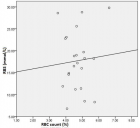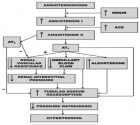Abstract
Research Article
Genetic variability, divergence, and path coefficient analysis of yield and yield related traits of Durum wheat (Triticum turgidum l. var. Durum) genotypes at Jamma district, south wollo zone, amhara region, Ethiopia
Haile Tefera*
Published: 04 July, 2022 | Volume 6 - Issue 2 | Pages: 075-083
Durum wheat (Triticum turgidum L. var. durum) is a member of the Poaceae family and tetraploid (genomes of AABB) with 28 chromosomes (2n=4x=28). Narrow genetic variability was a problem to develop genotypes with better adaptation to different agro-ecologies. Therefore, the objective of this study was to investigate the genetic variability, divergence, and path coefficient analysis of durum wheat genotypes by using morphological traits and identifying essential yield-related traits of durum wheat, and to identify promising candidate genotypes to be used in future durum wheat breeding program. The study was carried out on 81 genotypes and the experiment was laid out in a triple lattice design with an arrangement of 9 x 9 x 3 treatment, which made 243 experimental units. Results obtained on genetic variability, path coefficient, and genetic divergent analysis among yield-related traits are presented here under the present study. Generally, the present study revealed the existence of significant genetic variability among the tested genotypes for different traits helpful for direct and indirect selection.
This study recommended that the potential durum wheat genotypes 214552, 208150, 238516, 5645, Mekuye, 236984, 7960, 7152, 231599, and 208242 could be used for durum wheat breeding programs for yield and yield component traits improvement under similar agro-ecologies.
Read Full Article HTML DOI: 10.29328/journal.jpsp.1001078 Cite this Article Read Full Article PDF
Keywords:
Divergence; Genotype; Phenotype; Triticum durum
References
- Zecevic V, Boskovic J, Dimitrijevic M, Petrovic S. Genetic and phenotypic variability of yield components in wheat (triticum aestivum l). Bulgarian Journal of Agricultural Science, 2010; 16(4), 422–428. https://doi.org/10.2298/gensr0402151z
- Sahri A, Chentoufi L, Arbaoui M, Ardisson M, Belqadi L, Birouk A, Roumet P, Muller MH. Towards a comprehensive characterization of durum wheat landraces in Moroccan traditional agrosystems: analysing genetic diversity in the light of geography, farmers' taxonomy and tetraploid wheat domestication history. BMC Evol Biol. 2014 Dec 21;14:264. doi: 10.1186/s12862-014-0264-2. PMID: 25528060; PMCID: PMC4300848.
- AhmadizadehM, ShahbazH, Valizadeh M, Zaefizadeh M. Genetic diversity of durum wheat landraces using multivariate analysis under normal irrigation and drought stress conditions. African Journal of Agricultural Research, 2011; 6(10), 2294–2302.
- Mehdiabadi S, Mohammadi R, Etminan AR, Shooshtari L. Evaluation of Genetic Diversity in Durum Wheat Advanced Lines. 2015; 7(1), 236–240.
- Tsegaye D, Dessalegn T, Dessalegn Y, Share G. Genetic variability, correlation and path analysis in durum wheat germplasm (Triticum durum Desf). Agricultural Research and Reviews, 1(May), 2012; 107–112.
- Jaradat AA. Ecogeography, genetic diversity, and breeding value of wild emmer wheat (Triticum dicoccoides Körn ex Asch. & Graebn) Thell. Australian Journal of Crop Science, 5(9 SPEC. ISSUE), 2011; 1072–1086.
- Habash DZ, Kehel Z, Nachit M. Genomic approaches for designing durum wheat ready for climate change with a focus on drought. J Exp Bot. 2009;60(10):2805-15. doi: 10.1093/jxb/erp211. Erratum in: J Exp Bot. 2010 Feb;61(4):1249. PMID: 19584119.
- Zaeifizadeh M, Khayatnezhad M, Ghasemi M, Azimi J, VahabzadehPath analysis of yield and yield components in synthetic bread wheat (Triticum aestivum L) genotypes. Advances in Environmental Biology, 2011; 5(1), 98–103.
- Singh AK, Singh D. Genetic variability, heritability and genetic advance in marigold. Indian Journal of Horticulture, 2010; 67(1), 132–136.
- Berhanu M, Wassu M, Yemane T. Genetic variability, correlation and path analysis of yield and grain quality traits in bread wheat (Tritium aestivum L) genotypes at Axum, Northern Ethiopia. Journal of Plant Breeding and Crop Science, 2017; 9(10), 175–185. https://doi.org/10.5897/jpbcs2017.0671
- Medouri A, Bellil I, Khelifi D. Genetic diversity of high and low molecular weight glutenin subunits in algerian aegilops geniculata. Notulae Botanicae Horti Agrobotanici Cluj-Napoca, 2014; 42(2), 453–459. https://doi.org/10.1583/nbha4229511
- Qureshi N, Bariana H, Kolmer JA, Miah H, Bansal U. Genetic and Molecular Characterization of Leaf Rust Resistance in Two Durum Wheat Landraces. Phytopathology. 2017 Nov;107(11):1381-1387. doi: 10.1094/PHYTO-01-17-0005-R. Epub 2017 Aug 16. PMID: 28812937.
- Sciacca F, Fichera C, Di Silvestro S, Conte E, Palumbo M. Genetic diversity of durum wheat as determined by AFLP in fluorescence. Biologia Plantarum, 2010; 54(1), 198–200. https://doi.org/10.1007/s10535-010-0035-x
- Soriano JM, Villegas D, Aranzana MJ, García Del Moral LF, Royo C. Genetic Structure of Modern Durum Wheat Cultivars and Mediterranean Landraces Matches with Their Agronomic Performance. PLoS One. 2016 Aug 11;11(8):e0160983. doi: 10.1371/journal.pone.0160983. PMID: 27513751; PMCID: PMC4981446.
- Johnson M, Johnson M. Association Mapping and Genetic Diversity Studies of Agronomic and Quality Traits in Durum Wheat [Triticum turgidum L. var. durum (Desf.)]. November. 2017. https://library.ndsu.edu/ir/handle/10365/27462
Figures:
Similar Articles
-
HBV: Genomic Structure, HBVsAg Isolation and innovative Virotherapy Initiation in the Middle EastAboul-Ata E Aboul-Ata*,Essam M Janahi,I M El-Kalamawy,Kathleen Hefferon,Amal Mahmoud. HBV: Genomic Structure, HBVsAg Isolation and innovative Virotherapy Initiation in the Middle East . . 2017 doi: 10.29328/journal.jpsp.1001007; 1: 059-061
-
Reaction of Psidium guineense and Psidium guajava genotypes to infection of Meloidogyne enterolobiiRômulo M de Moraes Filho*,Edilton de Albuquerque Cavalcanti Jr,Jackeline Gadé A Rossiter,Angélica Virginia Valois Montarroyos,Luiza Suely Semen Martins. Reaction of Psidium guineense and Psidium guajava genotypes to infection of Meloidogyne enterolobii. . 2018 doi: 10.29328/journal.jpsp.1001015; 2: 015-019
-
Current challenges in plant breeding to achieve zero hunger and overcome biotic and abiotic stresses induced by the global climate changes: A reviewGniech Karasawa Marines Marli*. Current challenges in plant breeding to achieve zero hunger and overcome biotic and abiotic stresses induced by the global climate changes: A review. . 2021 doi: 10.29328/journal.jpsp.1001060; 5: 053-057
-
Genetic variability, divergence, and path coefficient analysis of yield and yield related traits of Durum wheat (Triticum turgidum l. var. Durum) genotypes at Jamma district, south wollo zone, amhara region, EthiopiaHaile Tefera*. Genetic variability, divergence, and path coefficient analysis of yield and yield related traits of Durum wheat (Triticum turgidum l. var. Durum) genotypes at Jamma district, south wollo zone, amhara region, Ethiopia. . 2022 doi: 10.29328/journal.jpsp.1001078; 6: 075-083
-
A look at polyploidy and plant breedingJesica Iannicelli,Alejandro S Escandón*. A look at polyploidy and plant breeding. . 2022 doi: 10.29328/journal.jpsp.1001092; 6: 163-166
-
Agro-morphological Growth Response of Acha (FONIO) (Digitaria exilis and Digitaria iburua [Kippist] Stapf.) Exposed to Colchicine: Germination, Plant Height and Leaf NumberNyam DD*, Gonzuk NS, Sila MD, Tumba YC, Angyu EA, Kwon-Ndung EH. Agro-morphological Growth Response of Acha (FONIO) (Digitaria exilis and Digitaria iburua [Kippist] Stapf.) Exposed to Colchicine: Germination, Plant Height and Leaf Number. . 2024 doi: 10.29328/journal.jpsp.1001133; 8: 055-059
Recently Viewed
-
Pneumothorax as Complication of CT Guided Lung Biopsy: Frequency, Severity and Assessment of Risk FactorsGaurav Raj*,Neha Kumari,Neha Singh,Kaustubh Gupta,Anurag Gupta,Pradyuman Singh,Hemant Gupta. Pneumothorax as Complication of CT Guided Lung Biopsy: Frequency, Severity and Assessment of Risk Factors. J Radiol Oncol. 2025: doi: 10.29328/journal.jro.1001075; 9: 012-016
-
The Police Power of the National Health Surveillance Agency – ANVISADimas Augusto da Silva*,Rafaela Marinho da Silva. The Police Power of the National Health Surveillance Agency – ANVISA. Arch Cancer Sci Ther. 2024: doi: 10.29328/journal.acst.1001046; 8: 063-076
-
A Comparative Study of Serum Sodium and Potassium Levels across the Three Trimesters of PregnancyOtoikhila OC and Seriki SA*. A Comparative Study of Serum Sodium and Potassium Levels across the Three Trimesters of Pregnancy. Clin J Obstet Gynecol. 2023: doi: 10.29328/journal.cjog.1001137; 6: 108-116
-
Chaos to Cosmos: Quantum Whispers and the Cosmic GenesisOwais Farooq*,Romana Zahoor*. Chaos to Cosmos: Quantum Whispers and the Cosmic Genesis. Int J Phys Res Appl. 2025: doi: 10.29328/journal.ijpra.1001107; 8: 017-023
-
Phytochemical Compounds and the Antifungal Activity of Centaurium pulchellum Ethanol Extracts in IraqNoor Jawad Khadhum, Neepal Imtair Al-Garaawi*, Antethar Jabbar Al-Edani. Phytochemical Compounds and the Antifungal Activity of Centaurium pulchellum Ethanol Extracts in Iraq. J Plant Sci Phytopathol. 2024: doi: 10.29328/journal.jpsp.1001137; 8: 079-083
Most Viewed
-
Evaluation of Biostimulants Based on Recovered Protein Hydrolysates from Animal By-products as Plant Growth EnhancersH Pérez-Aguilar*, M Lacruz-Asaro, F Arán-Ais. Evaluation of Biostimulants Based on Recovered Protein Hydrolysates from Animal By-products as Plant Growth Enhancers. J Plant Sci Phytopathol. 2023 doi: 10.29328/journal.jpsp.1001104; 7: 042-047
-
Sinonasal Myxoma Extending into the Orbit in a 4-Year Old: A Case PresentationJulian A Purrinos*, Ramzi Younis. Sinonasal Myxoma Extending into the Orbit in a 4-Year Old: A Case Presentation. Arch Case Rep. 2024 doi: 10.29328/journal.acr.1001099; 8: 075-077
-
Feasibility study of magnetic sensing for detecting single-neuron action potentialsDenis Tonini,Kai Wu,Renata Saha,Jian-Ping Wang*. Feasibility study of magnetic sensing for detecting single-neuron action potentials. Ann Biomed Sci Eng. 2022 doi: 10.29328/journal.abse.1001018; 6: 019-029
-
Pediatric Dysgerminoma: Unveiling a Rare Ovarian TumorFaten Limaiem*, Khalil Saffar, Ahmed Halouani. Pediatric Dysgerminoma: Unveiling a Rare Ovarian Tumor. Arch Case Rep. 2024 doi: 10.29328/journal.acr.1001087; 8: 010-013
-
Physical activity can change the physiological and psychological circumstances during COVID-19 pandemic: A narrative reviewKhashayar Maroufi*. Physical activity can change the physiological and psychological circumstances during COVID-19 pandemic: A narrative review. J Sports Med Ther. 2021 doi: 10.29328/journal.jsmt.1001051; 6: 001-007

HSPI: We're glad you're here. Please click "create a new Query" if you are a new visitor to our website and need further information from us.
If you are already a member of our network and need to keep track of any developments regarding a question you have already submitted, click "take me to my Query."






















































































































































